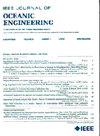设计、开发和测试用于多种应用的创新型自主水下可重构飞行器
IF 5.3
2区 工程技术
Q1 ENGINEERING, CIVIL
引用次数: 0
摘要
水下工业和科学界正在积极研究将自主水下航行器和远程操作航行器的功能结合起来的航行器的开发。自主水下可重构航行器(aurv)是解决水下勘探挑战的一种创新方法。这些车辆的设计是为了调整其配置以适应手头任务的要求。aurv的灵活性使它们能够承担各种水下任务,从科学研究到深海勘探。意大利佛罗伦萨大学工业工程系开发了一种创新的AURV,并获得了专利,该AURV能够快速改变形状以适应不同的任务。用于检查、自由浮动干预和调查任务的可重构水下航行器(RUVIFIST)配备了两种极端配置。第一种配置是细长的,用于长时间的导航任务,而第二种配置是结实的,用于处理复杂的目标,如检查或干预操作。RUVIFIST具有适应其形式以适应手头任务的能力,代表了水下航行器技术的重大进步。这项工作概述了在这款新车的开发过程中所面临的挑战和采用的解决方案。本文介绍了测试车辆可重构系统的实验活动的结果以及为aurv的制导、导航和控制系统开发的策略。最后,进行了初步测试,探索机器学习和深度学习算法的融合,以兼容自动目标识别的目的。本文章由计算机程序翻译,如有差异,请以英文原文为准。
Design, Development, and Testing of an Innovative Autonomous Underwater Reconfigurable Vehicle for Versatile Applications
The underwater industry and scientific community are actively researching the development of vehicles that combine the functionalities of autonomous underwater vehicles and remotely operated vehicles. An innovative approach to address the challenges posed by underwater exploration is the development of autonomous underwater reconfigurable vehicles (AURVs). These vehicles are designed to adapt their configuration to suit the requirements of the task at hand. The flexibility of AURVs enables them to undertake a variety of underwater missions, ranging from scientific research to deep-sea exploration. The Department of Industrial Engineering at the University of Florence, Italy, has developed and patented an innovative AURV that is able to quickly change its shape to suit different tasks. The reconfigurable underwater vehicle for inspection, free-floating intervention and survey tasks (RUVIFIST) have been equipped with two extreme configurations. The first configuration is a slender one meant for long navigation tasks, while the second configuration is a stocky one designed for tackling complex objectives such as inspection or intervention operations. With the ability to adapt its form to suit the task at hand, the RUVIFIST vehicle represents a significant advancement in underwater vehicle technology. This work provides an overview of the challenges faced and the solutions adopted during the development of this new vehicle. This article presents the results of experimental campaigns to test the reconfigurable system of the vehicle and the strategies developed for the guidance, navigation, and control system of AURVs. Finally, preliminary tests were conducted to explore the integration of machine learning and deep learning algorithms that are compatible with the purpose of automatic target recognition.
求助全文
通过发布文献求助,成功后即可免费获取论文全文。
去求助
来源期刊

IEEE Journal of Oceanic Engineering
工程技术-工程:大洋
CiteScore
9.60
自引率
12.20%
发文量
86
审稿时长
12 months
期刊介绍:
The IEEE Journal of Oceanic Engineering (ISSN 0364-9059) is the online-only quarterly publication of the IEEE Oceanic Engineering Society (IEEE OES). The scope of the Journal is the field of interest of the IEEE OES, which encompasses all aspects of science, engineering, and technology that address research, development, and operations pertaining to all bodies of water. This includes the creation of new capabilities and technologies from concept design through prototypes, testing, and operational systems to sense, explore, understand, develop, use, and responsibly manage natural resources.
 求助内容:
求助内容: 应助结果提醒方式:
应助结果提醒方式:


